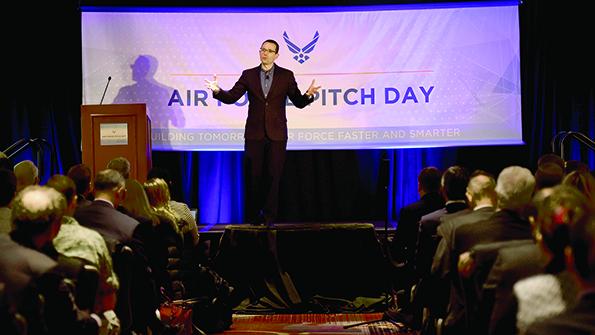
The U.S. Air Force has adopted a three-phase strategy to select small, innovative companies outside the traditional defense industry to perform advanced development work and to tap Silicon Valley-style venture capital firms to help taxpayers finance the new technology.
A new process could help rationalize the one-year-old Air Force effort to attract high-tech startups with dozens of Air Force Pitch Day events. These conferences have led to hundreds of small contract awards but no obvious path to guide the aspiring defense contractors further into the byzantine military acquisition process.
- U.S. Air Force plans to make 50 large “bets” on technology
- New acquisition training to be based on Fighter Weapons School
For the private startups and venture capitalists involved, the Air Force Ventures initiative is designed to offer a new route to the commercial market for potentially game-changing technologies that could benefit from a risk-tolerant government customer providing funding and early support.
“We don’t really think of ourselves as a [stand-alone] market, but we purchase things in quantities that [are] meaningful enough that we can bridge companies until they reach a level for commercial success,” says Will Roper, assistant secretary of the Air Force for acquisition, technology and logistics. “That’s one reason that [venture capitalists] are interested in this.”
The Air Force Ventures process starts with the Pitch Day events, during which the Air Force can place initial “bets” worth up to about $50,000 each in Phase I Small Business Innovation Research (SBIR) grants on promising, potentially game-changing ideas, says Roper, speaking to about 1,000 Air Force acquisition officials during a Feb. 14 webinar.
As the companies transition toward Phase II SBIR awards, the Air Force plans to grant about 300 contracts worth up to $1 million each—with a program office agreeing to fund about one-third of the costs. The funding match is meant to link the SBIR award to a program office, creating a path for the technology to potentially transition beyond the laboratory stage and into a program of record.
The third and final step in the Air Force Ventures concept whittles the pool of awards to about 50 recipients. The amount of the award is potentially “unlimited,” Roper says, but is generally regarded as at least $10 million.
The first of the “big bets” in Phase III are now under evaluation, Roper says. The contract awards could be announced at South by Southwest, a week-long technology conference and entertainment festival scheduled for March 13-22 in Austin, Texas.
The initiative explicitly seeks to help the Air Force break from traditional defense contractors. As the Air Force attempts to field leap-ahead capabilities within the next decade for the Advanced Battle Management System and Next-Generation Air Dominance, leveraging the innovative ideas and technology flowing into the commercial market is seen as critical.
“[R&D] in this country is 80% commercial,” Roper explains. “So in the 21st century, the [defense] industrial base should be dual-use. And so we’ve got to crack the code on how to have public and private funding work seamlessly inside an Air Force program.”
But there are significant challenges as the Air Force tries to leverage commercial-sector technology investments: Small companies often need to find a market quickly to generate revenue and cash flow, whereas government program offices tend to make decisions slowly—and inconsistently.
“In many cases, their commercialization [strategy] is devalued [by investors] if they have government funds,” Roper adds.
The Air Force’s program managers also face a learning curve.
“If we’re making 1,000 small bets a year, the reason we’re making 1,000 is that we know most of them aren’t going to pan out. So we can’t manage the companies the way we would a traditional program,” Roper says. “But we can manage them as a portfolio—the same way that a private investor or a venture capitalist would.”
To prepare, the Air Force is sending acquisition officials back to school. Next year, a cadre of program managers will be enrolled in a six-month course at Stanford University, which will teach the Air Force to manage technology investments like a venture capitalist, Roper says. The next step is to expand educational opportunities within the Air Force. A new acquisition curriculum, modeled on operational training centers such as the Fighter Weapons School, will be created, Roper says.

Comments